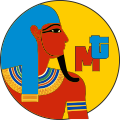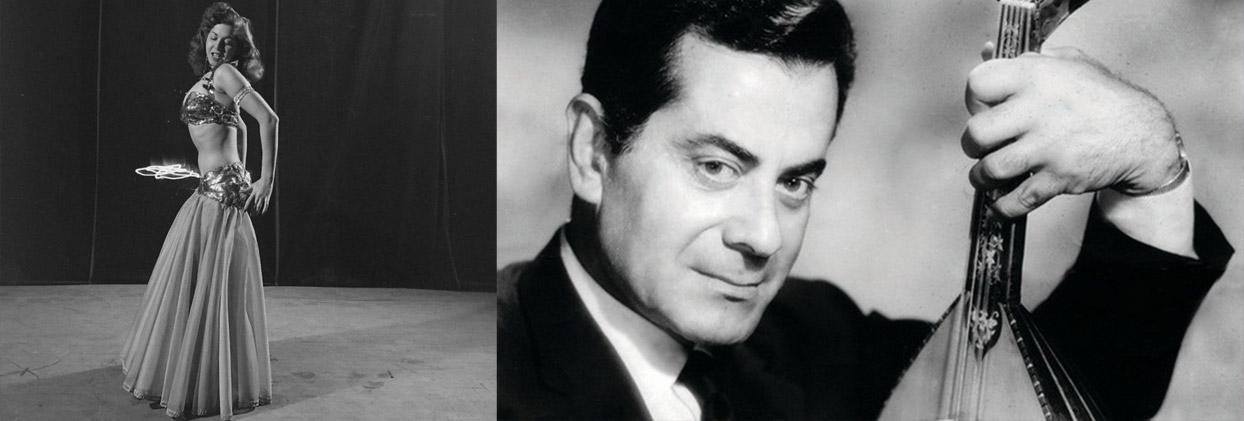The Egyptian civilization was one of the great civilizations that had deep-rooted values and persistent traditions. Despite the succession of different political rules, the Egyptian people kept their customs and traditions, most of which are still prevalent in daily life and social behaviors.
Being religious and acknowledging God's grace is a common phenomenon in Egyptian society. Religious rituals are habitually practiced at home. In ancient Egypt, there were special mihrabs, or prayer niches, for the pictures of idols. In the Coptic era as well, pictures of Christ and the Virgin Mary were found in every house. During the Islamic Age, verses of the Holy Qur'an, written in beautiful Arabic calligraphy, were popular in the homes. Adherence to religion, however, does not mean the Egyptians avoided the pleasant things in life; on the contrary, Egyptians joyfully embraced life, as evident in their jokes, songs, love chants, and folk arts.
One of the most important characteristics of Egyptian society since the dawn of civilization is the cooperation among society members, resulting in a sort of allegiance with the authorities to face common dangers. Usually, relatives, family members, and friends congregate in times of hardship, death, or illness. Standing beside the afflicted person and his or her family was an unavoidable duty. The Egyptian was faithful, deplored vice, and held ethics as the standard by which people were appraised
Feasts and festivals played an important part in Egyptian life. In every age, there were new feasts to be celebrated. In the Pharaonic and Greco-Roman ages, there was a particular feast for every god, in which clergymen carried a statue of the god in a great procession that all people attended and at which clowns, singers, and dancers performed. Theatrical plays depicting myths were also performed. Celebrations for friendly gods such as Bes were held by the people rather than the priests. On the day of Bes, no work was done on the pyramid and people would parade down the street dressed in masks of Bes, while dancers and tambourine players followed. The townspeople joined in the singing from their rooftops, while the children would run along beside the dancers singing and clapping their hands. The whole town enjoyed the festival and feast.
Other occasions were New Year's Day and various feasts for the beginning of the seasons. There was the feast of flood tide that is known in the modern age as Nile Flood Day. In addition, there is the feast of spring, which is currently called Sham El-Nassem. Egyptians still celebrate these two feasts. In the Christian age, there were Saints' Days, Epiphany, Christmas, and Easter. These feasts are still celebrated by Egyptians and some of them are celebrated by both Muslims and Christians, such as Epiphany and Christmas.
In the Islamic Age, particularly in the Fatimid era, the rulers added some processions to share with the people when celebrating their feasts. These processions were headed by thousands of horsemen and lines of camels, upon which brocaded howdahs, or seats adorned with flowers, were fixed. Banquets were also prepared. Certain dishes, traditions, and customs connected to feasts and ceremonies are still celebrated, among which are the Prophet's Birthday, the Outset of Ragab, the Middle and Outset of Sha'aban, the Tenth of Moharam, the New Hijri Year's Day, and the Outset of Ramadan, in addition to the two Islamic feasts, the Lesser Bairam and the Greater Bairam.
Animals were very important to the ancient Egyptians. Unlike other ancient cultures, whose gods looked somewhat like people, most ancient Egyptian gods had animal heads. Any person who killed a sacred animal could pay for that crime with his or her life.
Since Egyptians believed in an afterlife, they believed that people enjoyed many of the same activities after death as they did in their current life. They prepared for their afterlife by filling their tombs with small and large statutes of friends and family, and with other items they might need to keep them company and to help them have a good time in the afterlife.
The ancient Egyptians enjoyed their life to the fullest. They worked very hard, but saved time to enjoy family, friends, music, parties, swimming, fishing, hunting, sailing, and especially their children, all of which were very important to them
The people of ancient Egypt held marriage as a sacred bond and highly valued family life. This has been made clear in the many statues and writings that depict men and women in an intimate relationship where both depended upon each other and statues that show the nuclear family.
Kinship marriage was popular among Egyptians in order to ensure that the spouses have close social levels and to promote the kinship ties. The bride could also be chosen from the close acquaintances of the family. Girls usually married around the age of 12. Most of the marriage costs were usually divided between both families. While the bridegroom and his family gave a proper amount of money and provided housing, the bride’s family provided furniture and the movable objects. Marriage ceremonies and banquets were held where family members gathered to celebrate, and gifts were presented to the couple from relatives and friends. This tradition has been familiar to Egyptians throughout history.
Family members shared responsibilities where each had a specific role to play in order for things to run smoothly. The father was the one who would work all day. In smaller households the mother was in charge of all things pertaining to the house. Cooking, cleaning, and watching the children were all her responsibilities. In some larger homes servants served as maids and midwives to help the mother.
Egyptians treasured children and regarded them as a great blessing. If a couple had no children, they would pray to the gods and goddesses for help. In the event that a couple still could not conceive a child, adoption was also an option.
Small children used to play with dolls, toys, and games until they come of age. Young boys learned a trade or craft from their fathers or an artisan. Young girls worked and received their training at home with their mothers. Those who could afford it sent their sons, from about the age of seven, to school to study religion, reading, writing, and arithmetic. Even though there is no evidence of schools for girls, some were home taught to read and write and some even became doctors.
Woman always had a distinct status in the social and family life. Although women were expected to raise the children and take care of the household duties, there were some jobs available to them. Women ran farms and businesses in the absence of their husbands or sons. Women were employed in courts and temples as acrobats, dancers, singers, and musicians. Wealthy families hired maids or nannies to help with household chores and the raising of the children. Noblewomen could become priestesses. Women also worked as professional mourners and perfume makers. A woman could have separate financial assets other than that of her husband. In addition, she was entitled to possess, dispose independently with, grant, and bequeath private properties as she liked. Women were equally accountable under the law. A woman who was convicted of a capital crime in a court of law would be executed, but only after the court determined that the woman was not pregnant. If such a woman was found to be pregnant, her execution was delayed until after the birth of the child
Since the prehistoric age, Egyptians believed that all aspects of life were controlled by supernatural powers. One important religious concept was the creation of the universe. For the Egyptians, creation was essentially an act of generation, represented by the yearly flooding of the Nile River. Each day was also considered a repetition of the act of creation. As the sun, represented by Atum, traveled across the sky to rise and set and begin the cycle again, so the Egyptians felt assured that the created order of their world was eternal and ongoing.
Unlike modern religions, which are based on a set of theological principles, the ancient Egyptian religion was concerned with interactions between people and their gods, the ethics of dealing with others, and the performance of spiritual duties. The universe was believed to work according to a strict eternal law, Ma’at, which means Right or Balance. For the Egyptian, the universe functioned with predictability and regularity. In the moral sphere, purity was rewarded and sin was punished. Man had to subdue his desires and actions to that law in order to live a good life so that society would be on the right track.
Some deities were worshiped countrywide and others were worshiped in certain regions. The worship of a number of gods was a distinguishing feature of the ancient Egyptian religion until the reign of Akhenaten. Akhenaten unified all the gods in the image of one single god, which he named Aten, the sun god. This god was depicted as a solar disk, sometimes with wings or with life-giving hands on rays. After Akhenaten's death, the Egyptians returned to their previous religious traditions.
In the Greek era, Ptolemy the First introduced Serapis to Egypt so that both Egyptians and Greeks would have a supreme deity in common. Serapis was a composite of several Egyptian and Hellenistic deities, especially Osiris and the bull Apis. The official trinity of the Ptolemaic period was Serapis, Isis, and Harpocrates. The temple of Serapis was constructed in Koum Al-Dekka in Alexandria and his legacy lasted well into the Roman period. The Roman Empire's policy of religious tolerance paved the way for ancient religions to mix with each other. Isis, for example, was worshiped throughout the Roman Empire.
The history of Christianity in Egypt dates back to the beginnings of Christianity itself. Many Christians hold that Christianity was brought to Egypt by the Apostle Saint Mark in the early part of the first century AD. Important Christian manuscripts, the oldest of which date back to the second century AD, have been found, such as the papers of the Bible of Saint John and a Christian Bible. Although Christianity was readily embraced by many, the Roman emperors persecuted Christianity until the reign of Emperor Galenus. Nevertheless, Christians went on worshiping in secret and had various unofficial schools. The reign of Emperor Constantine was the real birth of Christianity, as it was then declared the official religion of the Roman Empire.
By the fourth century AD, Egypt had contributed to Christian literature, including biographies of the heroes and martyrs. Many groups and schools emerged with different religious concepts, mainly about the nature of Jesus, which led to a great controversy. That controversy reached its climax when the Orthodox Church of Alexandria separated from the Roman Church. Most of the Egyptian Christians follow the Orthodox Church.
The spread of Islam in Egypt was totally different from that of Christianity. Islam came into Egypt after its diffusion into all parts of the Arab Peninsula and the completion of its basic beliefs. Those who follow Islam believe the Qur'an is the final revealed Word of God that provides a complete guide for human behavior. Its text was revealed directly to the prophet Muhammad, who is revered by Muslims as the last of God’s prophets, but he is not worshiped. However, the richest contribution of Egypt to the Islamic religion was the Sufi movement, which emerged in Egypt at the end of the second century AH (eighth century AD). A Sufi is a mystic, meaning the practitioner has a greater awareness and lives on a higher plane than which we normally liv


